Prong Collar: Yes or No?
by Tom Antion
I’ve got to say yes from my limited experience. When I first got Rubix, my personal protection dog, he would pull on the leash a little under heavy distractions like running squirrels or some other male dogs. As soon as I learned how to put a prong collar on him correctly, he turned in to the angel of all angels.
A prong collar, AKA pinch collar allowed me to take Rubix to Petsmart before he even wanted to listen to me. The little angel would hug my leg for walking. When I first got him he would never do that with just a plain collar.
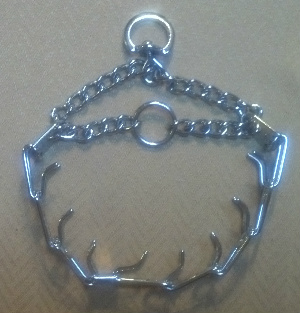
Looks pretty nasty doesn’t it? It’s actually one of the most humane collars because it will only close to a certain point.
Yes, I know they look ominous, but they are actually less dangerous than a choker / slip collar because they will only close so far. The choker or slip collar (if you’re not careful) will just keep tightening until it chokes the dog and damages its neck. When used properly, prong collars are much easier on the dog.
From what I’ve read, prong collars are designed to ‘pinch’ the dogs neck as if he’s getting bitten on the neck by another dog or his mother. I’m in big favor of them. For me they work beautifully.
It also let my 110 pound assistant easily handle the dog as soon as he arrived. I’m not saying he was a wild puller. The company I got him from trained him better than that. I’m just saying a dog in a new environment can get pretty excited and needs a firm hand to control him. Also, it really helped the socialization of this dog. Right off the bat I was able to take him places I wouldn’t have been able to take him until I learned better control. The old joke is that a prong collar is like “Power Steering” for a dog.
Types of Prong Collars
There are several types of prong collars. The standard prong collar must be taken apart and put back together around the dog’s neck. You cannot slide the collar over the dog’s head. It must fit snugly and would never make it if you tried to slip it on. You adjust these collars by taking out or putting in links.
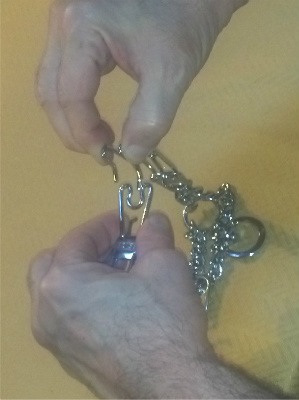
Standard prong collars are put on the personal protection dog by pinching and unhooking a link and then re-linking it after it’s around the dog’s neck.
You also have quick release prong collars. Some people don’t think these are secure enough, but when using the extra safety collar I’ll mention later, I don’t see any problem with quick release prong collars.
Then you have the low profile prong collar that sports shorter and wider prongs.
If your dog has long hair, sometimes the hair can get caught in the prongs so watch out for that when you put the collar on.
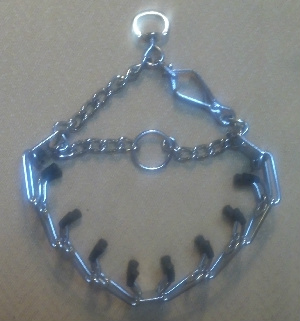
This type of quick release prong collar has a clip that holds on to part of a chain. This prong collar has add-on plastic tips to reduce the irritation to the dog’s neck. I also found that the plastic tips reduced the control of the collar slightly.
Safety
Because of the nature of how a prong collar is made, it is possible that it could come apart on you some time when you really need it. It’s never happened to me, but I’m not that experienced using them. As a precaution I keep an extra long choker collar on Rubix when I’m using the prong collar.
The prong collar is put on very snugly and high on the dog’s neck. It only takes a few inches of pull on the leash to get it to do its job. I also attach the leash to the choker collar. Since the choker collar is so long, when I pull the leash to make a correction, the choker collar never tightens up.
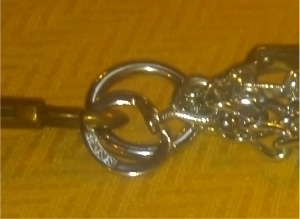
For safety use an extra long choker / slip collar and put the leash on both the choker collar and the prong collar. If the prong collar breaks, you still have control of the dog using the choker collar.
However, if the prong collar should break, the leash is still attached to the choker collar and I’m not faced with a dog running loose. Note: I don’t really bother with the backup choker collar if I’m working with my dog in a totally safe fenced in yard.
Prong Gone Wrong
This is another great example of getting professional help. I did my research. I read a ton of articles. I watched probably 40 YouTube videos on the subject of prong collars and I stilled screwed up. One article from a very credible source suggested that I leave the prong collar on my dog 24/7 for the first few months. His argument was that the risk of doing so was far less than the risk of my dog running in front of a car.
This sounded reasonable to me. When I got my dog I wanted to take firm and immediate control of him. Since the prong collar made him act like a little angel, I thought this was good advice.
I was wrong
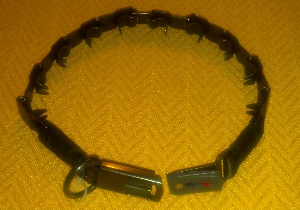
Low profile Herm Sprenger prong collar. This one has a different type of quick release clasp. Unfortunately this collar did not work well on my German Shepherd’s long haired neck.
Yes, the dog acted like a little angel all the time. No the dog did not complain or whine that the collar was on. Was this a good idea? HELL NO!
After a couple weeks I was getting ready to give my dog a bath and I removed the prong collar. I rubbed my dog’s neck and I felt what appeared to be hair knots on his neck. I figured the prong collar had just tangled in his neck hair for the last couple weeks and that it would be no big deal.
As I inspected the knots closer…..OUCH! The hair knots were full of dried blood and scabs. The dog’s neck was totally irritated and I had been the cause of it. I was devastated. How could I have done this to this innocent creature that depends on me for his entire existence?
It took two weeks for all the irritations to heal and the scabs to come off. Now Rubix wears the prong collar with plastic no irritation tips applied and I remove it each night and give him a neck massage.
So, I say YES to prong collars so long as you get professional help to learn to use them properly.
WATCH THE PRONG COLLAR VIDEO IN OUR PROTECTION DOG GLOSSARY
BACK TO CONFESSIONS OF A NEW PERSONAL PROTECTION DOG OWNER


